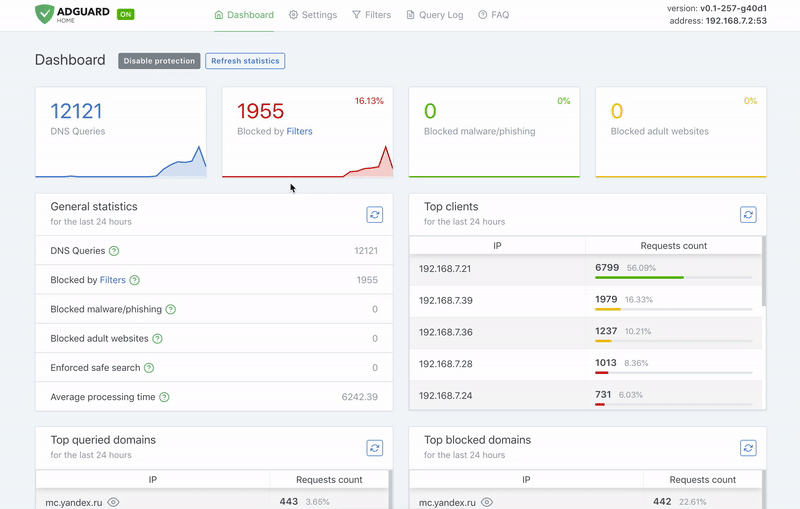Free and open source, powerful network-wide ads & trackers blocking DNS server.
AdGuard.com |
Wiki |
Reddit |
Twitter |
Telegram




AdGuard Home is a network-wide software for blocking ads & tracking. After you set it up, it'll cover ALL your home devices, and you don't need any client-side software for that.
It operates as a DNS server that re-routes tracking domains to a "black hole," thus preventing your devices from connecting to those servers. It's based on software we use for our public AdGuard DNS servers -- both share a lot of common code.
- Getting Started
- Comparing AdGuard Home to other solutions
- How to build from source
- Contributing
- Projects that use AdGuardHome
- Acknowledgments
Please read the Getting Started article on our Wiki to learn how to install AdGuard Home, and how to configure your devices to use it.
If you're running Linux, there's a secure and easy way to install AdGuard Home - you can get it from the Snap Store.
Alternatively, you can use our official Docker image.
- Configuration
- AdGuard Home as a DNS-over-HTTPS or DNS-over-TLS server
- How to install and run AdGuard Home on Raspberry Pi
- How to install and run AdGuard Home on a Virtual Private Server
- How to write your own hosts blocklists properly
If you want to integrate with AdGuard Home, you can use our REST API. Alternatively, you can use this python client, which is used to build the AdGuard Home Hass.io Add-on.
Running your own AdGuard Home server allows you to do much more than using a public DNS server. It's a completely different level. See for yourself:
- Choose what exactly will the server block or not block.
- Monitor your network activity.
- Add your own custom filtering rules.
- Most importantly, this is your own server, and you are the only one who's in control.
At this point, AdGuard Home has a lot in common with Pi-Hole. Both block ads and trackers using "DNS sinkholing" method, and both allow customizing what's blocked.
We're not going to stop here. DNS sinkholing is not a bad starting point, but this is just the beginning.
AdGuard Home provides a lot of features out-of-the-box with no need to install and configure additional software. We want it to be simple to the point when even casual users can set it up with minimal effort.
Disclaimer: some of the listed features can be added to Pi-Hole by installing additional software or by manually using SSH terminal and reconfiguring one of the utilities Pi-Hole consists of. However, in our opinion, this cannot be legitimately counted as a Pi-Hole's feature.
| Feature | AdGuard Home | Pi-Hole |
|---|---|---|
| Blocking ads and trackers | ✅ | ✅ |
| Customizing blocklists | ✅ | ✅ |
| Built-in DHCP server | ✅ | ✅ |
| HTTPS for the Admin interface | ✅ | Kind of, but you'll need to manually configure lighthttpd |
| Encrypted DNS upstream servers (DNS-over-HTTPS, DNS-over-TLS, DNSCrypt) | ✅ | ❌ (requires additional software) |
| Cross-platform | ✅ | ❌ (not natively, only via Docker) |
| Running as a DNS-over-HTTPS or DNS-over-TLS server | ✅ | ❌ (requires additional software) |
| Blocking phishing and malware domains | ✅ | ❌ |
| Parental control (blocking adult domains) | ✅ | ❌ |
| Force Safe search on search engines | ✅ | ❌ |
| Per-client (device) configuration | ✅ | ❌ |
| Access settings (choose who can use AGH DNS) | ✅ | ❌ |
It depends.
"DNS sinkholing" is capable of blocking a big percentage of ads, but it lacks flexibility and power of traditional ad blockers. You can get a good impression about the difference between these methods by reading this article. It compares AdGuard for Android (a traditional ad blocker) to hosts-level ad blockers (which are almost identical to DNS-based blockers in their capabilities). However, this level of protection is enough for some users. Additionally, using a DNS-based blocker can help to block ads, tracking and analytics requests on other types of devices, such as SmartTVs, smart speakers or other kinds of IoT devices (on which you can't install tradtional ad blockers).
You will need:
You can either install them via the provided links or use brew.sh if you're on Mac:
brew install go nodeOpen Terminal and execute these commands:
git clone https://github.com/AdguardTeam/AdGuardHome
cd AdGuardHome
makenode upload.js
node download.js
You are welcome to fork this repository, make your changes and submit a pull request — https://github.com/AdguardTeam/AdGuardHome/pulls
There are three options how you can install an unstable version.
- You can either install a beta version of AdGuard Home which we update periodically.
- You can use the Docker image from the
edgetag, which is synced with the repo master branch. - You can install AdGuard Home from
betaoredgechannels on the Snap Store.
- Beta builds
- Docker Hub
- Snap Store
If you run into any problem or have a suggestion, head to this page and click on the New issue button.
If you want to help with AdGuard Home translations, please learn more about translating AdGuard products here: https://kb.adguard.com/en/general/adguard-translations
Here is a link to AdGuard Home project: https://crowdin.com/project/adguard-applications/en#/adguard-home
- Python library (https://github.com/frenck/python-adguardhome)
- Hass.io add-on (https://github.com/hassio-addons/addon-adguard-home)
- OpenWrt LUCI app (https://github.com/rufengsuixing/luci-app-adguardhome)
This software wouldn't have been possible without:
- Go and it's libraries:
- Node.js and it's libraries:
- whotracks.me data
You might have seen that CoreDNS was mentioned here before — we've stopped using it in AdGuardHome. While we still use it on our servers for AdGuard DNS service, it seemed like an overkill for Home as it impeded with Home features that we plan to implement.
For a full list of all node.js packages in use, please take a look at client/package.json file.
For info on which exact domains that are blocked by the Blocked services function, it can be found at dnsfilter/blocked_services.go

